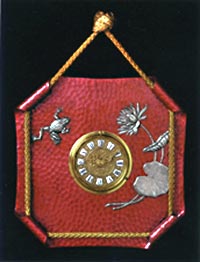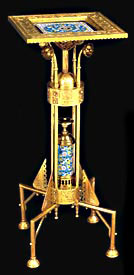Brass Menagerie Showcases American Brass of the Aesthetic Movement
 Clock, 1880
Clock, 1880Patinated copper, silver, brass, other metals, fiber rope
A Brass Menagerie: Metalwork of the Aesthetic Movement is being presented at The Bard Graduate Center for Studies in the Decorative Arts, Design, and Culture through October 14. Organized by Anna Tobin D’Ambrosio, curator of decorative arts at the Munson-Williams-Proctor Arts Institute Museum of Art in Utica, New York, where the exhibition originated, this exhibition contains approximately 75 pieces of brass and mixed-metal furniture as well as accessories ranging from chandeliers and andirons to door hardware, hanging shelves, and clocks. The exhibition continues the Bard Graduate Center’s examination of the Aesthetic Movement, this time with the focus on the United States. It is the first in-depth examination of this multifaceted aspect of the Aesthetic movement in America.
The Aesthetic movement was a late-19th -century artistic movement in England and America. Formed in reaction to the so-called philistine tastes of the middle class, it espoused art for art’s sake while denying any social or moral value in art (both James McNeill Whistler and Oscar Wilde were advocates, and were thoroughly lampooned in Gilbert and Sullivan’s Patience). In America the movement was introduced at the American Centennial celebration in Philadelphia in 1876. It remained popular in this country through the 1880s and was particularly evident in the decorative arts, as manufacturers created innovative and artistic applications of industrial metals that were visually and materially complex and called “art brass” or “artistic bronze goods.
 Table, circa 1880-85
Table, circa 1880-85Brass, earthenware, Bradley & Hubbard Mfg. Co. Collection of Munson-WilliamsProctor-Arts Institute Museum of Art
Most of the most pioneering manufacturers of aesthetic-style metals—such as The Charles Parker Company and Bradley & Hubbard Manufacturing Co., both of Meriden, Connecticut, and New York City’s P.E. Guerin Foundry—are represented in the exhibition by numerous objects that show the range and diversity of their products. Among the most imaginative decorative arts in the exhibition are Parker Company hanging shelves, tables, and a lamp, all with silver-plated surfaces outlined in brass and embellished by gold- and silver-plated, three-dimensional decoration. The furniture design is an interesting mixture of Anglo Japanesque and Modern Gothic forms executed in interchangeable machined elements with Japanesque surface finish and ornamentation.
Many motifs found on aesthetic metals are derived from Japanese art, such as the dragon-like creatures and butterflies that adorn a table by Ansonia Copper & Brass Company of Ansonia, Connecticut, or the stylized Japanese crest images and clouds that embellish other tables. The crane motif, also derived from Japanese art and culture where it symbolizes longevity, pervaded the ornamentation of art brass goods. R. Hollings & Co. of Boston incorporated this theme into an exotic-looking floor lamp made about 1886 and accented by earthenware tiles patented by J. and G. Low Art Tile Works of Chelsea, Massachusetts.
Japonisme is even more dominant in the door hardware made during the same period. Richly decorated doorknobs, escutcheons, and hinges that feature fully articulated Japanese figures and architecture highlight A Brass Menagerie. Vibrant polychrome ceramics and exotic flourishes drawn from Moorish and Persian designs accent the wares made by other firms, such as tables made by Bradley & Hubbard and lamps by a host of other companies. Art brass maximized industrial mass production techniques and helped to set the stage for 20th -century decorative arts that would also utilize tubular metals and other industrial materials in the creation of decorative household goods.
An array of lectures, panels, and other offerings will be presented in conjunction with A Brass Menagerie: Metalwork of the Aesthetic Movement. Group tours may be scheduled Tuesday through Friday between 11 a.m. and 4 p.m., and on Thursdays until 7 p.m. Reservations are required for all groups.
Resources:
Also in this Issue:
- The Guggenheim Legacy: From Copper to Contemporary Art
- Amy Kupferberg, Alchemy and Meaning
- Steven Whyte Finds Common Ground with His Real-Life Bronze Portraits
- The Statue of Liberty: A Shining Example of Copper's Endurance
- Brass Menagerie Showcases American Brass of the Aesthetic Movement
